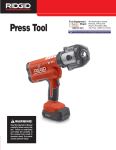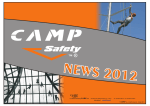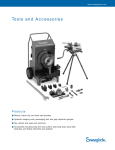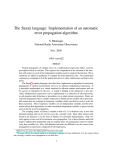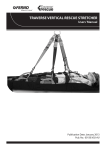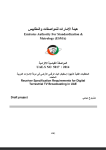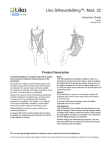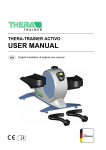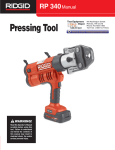Download RIDGID RP 330-B Operator`s manual
Transcript
RP 330 Manual Pressing Tool WARNING! Read this Operator’s Manual carefully before using this tool. Failure to understand and follow the contents of this manual may result in electrical shock, fire and/or serious personal injury. 99 Washington Street Melrose, MA 02176 Phone 781-665-1400 Toll Free 1-800-517-8431 Visit us at www.TestEquipmentDepot.com RP 330 Pressing Tool Table of Contents Recording Form for Machine Serial Number ..............................................................................................................1 General Power Tool Safety Information Work Area Safety........................................................................................................................................................2 Electrical Safety ..........................................................................................................................................................2 Personal Safety ..........................................................................................................................................................3 Power Tool Use and Care ..........................................................................................................................................3 Battery Tool Use and Care ........................................................................................................................................3 Service ........................................................................................................................................................................3 Specific Safety Information Pressing Tool Safety ..................................................................................................................................................4 Battery and Charger Safety ........................................................................................................................................4 Description and Specifications Description ..................................................................................................................................................................4 Specifications..............................................................................................................................................................5 Tool Inspection..............................................................................................................................................................5 Tool and Work Area Set-Up..........................................................................................................................................6 Operating Instructions Preparing the Connection ..........................................................................................................................................7 Pressing A Fitting With Typical Scissor Jaw Set ........................................................................................................7 Pressing A Fitting With Typical Actuator and Press Ring Set ....................................................................................8 Inspecting The Pressed Connection ..........................................................................................................................9 Maintenance Instructions Cleaning and Lubrication ..........................................................................................................................................10 Required Maintenance at RIDGID Authorized Service Center ................................................................................10 Accessories ................................................................................................................................................................10 Storage ........................................................................................................................................................................10 Service and Repair ......................................................................................................................................................10 Troubleshooting ..........................................................................................................................................................11 RP 330 Diagnostic Codes ..........................................................................................................................................12 Lifetime Warranty ........................................................................................................................................Back Cover ii Test Equipment Depot - 800.517.8431 - 99 Washington Street Melrose, MA 02176 TestEquipmentDepot.com RP 330 Pressing Tool RP 330-B Battery Tool RP 330-C Corded Tool RP 330 Pressing Tool Record Serial Number below and retain product serial number which is located on nameplate. Serial No. Test Equipment Depot - 800.517.8431 - 99 Washington Street Melrose, MA 02176 - TestEquipmentDepot.com RP 330 Pressing Tool Safety Symbols In this operator’s manual and on the product, safety symbols and signal words are used to communicate important safety information. This section is provided to improve understanding of these signal words and symbols. This is the safety alert symbol. It is used to alert you to potential personal injury hazards. Obey all safety messages that follow this symbol to avoid possible injury or death. DANGER DANGER indicates a hazardous situation which, if not avoided, will result in death or serious injury. WARNING WARNING indicates a hazardous situation which, if not avoided, could result in death or serious injury. CAUTION CAUTION indicates a hazardous situation which, if not avoided, could result in minor or moderate injury. NOTICE NOTICE indicates information that relates to the protection of property. This symbol means read the operator’s manual carefully before using the equipment. The operator’s manual contains important information on the safe and proper operation of the equipment. This symbol means always wear safety glasses with side shields or goggles when handling or using this equipment. This symbol indicates the risk of hands, fingers or other body parts being crushed This is the electrical shock symbol. General Safety Rules* WARNING Read all safety warnings and instructions. Failure to follow the warnings and instructions may result in electric shock, fire and/or serious injury. SAVE ALL WARNINGS AND INSTRUCTIONS FOR FUTURE REFERENCE! The term "power tool" in the warnings refers to your mains-operated (corded) power tool or battery-operated (cordless) power tool. Work Area Safety • Keep your work area clean and well lit. Cluttered or dark areas invite accidents. • Do not operate power tools in explosive atmospheres, such as in the presence of flammable liquids, gases, or dust. Power tools create sparks which may ignite the dust or fumes. • Keep children and by-standers away while operating a power tool. Distractions can cause you to lose control. Electrical Safety • Power tool plugs must match the outlet. Never modify the plug in any way. Do not use any adapter plugs with earthed (grounded) power tools. Unmodified plugs and matching outlets will reduce risk of electric shock. • Avoid body contact with earthed or grounded surfaces such as pipes, radiators, ranges and refrigerators. There is an increased risk of electrical shock if your body is earthed or grounded. • Do not expose power tools to rain or wet conditions. Water entering a power tool will increase the risk of electrical shock. • Do not abuse the cord. Never use the cord for carrying, pulling or unplugging the power tool. Keep cord away from heat, oil, sharp edges or moving parts. Damaged or entangled cords increase the risk of electric shock. • When operating a power tool outdoors, use an extension cord suitable for outdoor use. Use of a cord suitable for outdoor use reduces the risk of electric shock. • If operating a power tool in a damp location is unavoidable, use a ground fault circuit interrupter (GFCI) protected supply. Use of a GFCI reduces the risk of electric shock. * The text used in the General Safety Rule section of this manual is verbatim, as required, from the applicable UL/CSA 60745 standard. This section contains general safety practices for many different types of power tools. Not every precaution applies to every tool, and some do not apply to this tool. 2 Ridge Tool Company RP 330 Pressing Tool Personal Safety • Stay alert, watch what you are doing and use common sense when operating a power tool. Do not use a power tool while you are tired or under the influence of drugs, alcohol, or medication. A moment of inattention while operating power tools may result in serious personal injury. • Use personal protective equipment. Always wear eye protection. Protective equipment such as dust mask, non-skid safety shoes, hard hat, or hearing protection used for appropriate conditions will reduce personal injuries. • Prevent unintentional starting. Ensure the switch is in the off-position before connecting to power source and/or battery pack, picking up or carrying the tool. Carrying power tools with your finger on the switch or energizing power tools that have the switch on invites accidents. • Remove any adjusting key or wrench before turning the power tool on. A wrench or a key left attached to a rotating part of the power tool may result in personal injury. • Store idle power tools out of the reach of children and do not allow persons unfamiliar with the power tool or these instructions to operate the power tool. Power tools are dangerous in the hands of untrained users. • Maintain power tools. Check for misalignment or binding of moving parts, breakage of parts and any other condition that may affect the power tool’s operation. If damaged, have the power tool repaired before use. Many accidents are caused by poorly maintained power tools. • Keep cutting tools sharp and clean. Properly maintained cutting tools with sharp cutting edges are less likely to bind and are easier to control. • Use the power tool, accessories and tool bits etc. in accordance with these instructions, taking into account the working conditions and the work to be performed. Use of the power tool for operations different from those intended could result in a hazardous situation. Battery Tool Use and Care • Do not overreach. Keep proper footing and balance at all times. This enables better control of the power tool in unexpected situations. • Recharge only with the charger specified by the manufacturer. A charger that is suitable for one type of battery pack may create a risk of fire when used with another battery pack. • Dress properly. Do not wear loose clothing or jewelry. Keep your hair, clothing, and gloves away from moving parts. Loose clothes, jewelry, or long hair can be caught in moving parts. • Use power tools only with specifically designated battery packs. Use of any other battery packs may create a risk of injury and fire. • If devices are provided for the connection of dust extraction and collection facilities, ensure these are connected and properly used. Use of dust collection can reduce dust-related hazards. Power Tool Use and Care • Do not force power tool. Use the correct power tool for your application. The correct power tool will do the job better and safer at the rate for which it is designed. • Do not use power tool if the switch does not turn it ON and OFF. Any power tool that cannot be controlled with the switch is dangerous and must be repaired. • Disconnect the plug from the power source and/or the battery pack from the power tool before making any adjustments, changing accessories, or storing power tools. Such preventive safety measures reduce the risk of starting the power tool accidentally. • When battery pack is not in use, keep it away from other metal objects, like paper clips, coins, keys, nails, screws or other small metal objects that can make a connection from one terminal to another. Shorting the battery terminals together may cause burns or a fire. • Under abusive conditions, liquid may be ejected from the battery; avoid contact. If contact accidentally occurs, flush with water. If liquid contacts eyes, additionally seek medical help. Liquid ejected from the battery may cause irritation or burns. Service • Have your power tool serviced by a qualified repair person using only identical replacement parts. This will ensure that the safety of the power tool is maintained. Ridge Tool Company 3 RP 330 Pressing Tool Specific Safety Information WARNING This section contains important safety information that is specific to this tool. Read these precautions carefully before using the RP 330 Pressing Tool to reduce the risk of electrical shock or serious personal injury. SAVE THESE INSTRUCTIONS! A compartment in the RP 330 carrying case is included to keep this manual with the machine for use by the operator. Pressing Tool Safety • Charge batteries only in the appropriate battery charger as specified in the charger manual. Other types of batteries or non-rechargeable batteries may burst resulting in personal injury and damage. • Do not probe battery with conductive objects. Shorting of battery terminals may cause sparks, burns or electrical shock. • Do not insert battery with cracked case into tool or charger. Do not operate battery if it has been dropped or damaged in any way. Damaged battery increases the risk of electrical shock. • Do not burn batteries for any reason. Batteries explode in fire. • Use the RP 330 Pressing Tool only with RIDGID Standard pressing attachments (jaw set, press ring, actuator, etc.). Other uses or modifying the RP 330 Pressing Tool for other applications may damage the pressing tool, damage the attachments and/or cause personal injury. • Charge batteries in temperatures above +41°F (+5°C) and below +113°F (45°C). Store tool and battery pack in locations where temperatures will not exceed +104°F (40°C). Proper care will prevent serious damage to batteries. Improper care of batteries may result in battery leakage, electrical shock or burns. • Keep your fingers and hands away from jaws during press cycle. Your fingers or hands can be crushed, fractured or amputated if they become caught between the jaws or between these components and any other object. • Do not allow anything to cover the charger while in use. May result in fire. • Never attempt to repair a damaged jaw set, press ring, actuator or other attachment. An attachment that has been welded, ground, drilled or modified in any manner can shatter during pressing resulting in serious injury. Discard the entire damaged jaw set. Replace with a new jaw set. Never replace individual components except for damaged jaw return springs. • Read and understand this operator’s manual, the jaw set instructions, the fitting manufacturer’s installation instructions and the instructions for any other equipment used with this tool before operating the RP 330. Failure to follow all instructions may result in property damage and/or serious personal injury. Battery and Charger Safety (for RP 330-B only) WARNING Read the battery charger manual before using the charger or batteries. Failure to read, understand and follow the contents of the charger manual may 4 result in extensive property damage, severe personal injury, or death. • Unplug the charger when not in use. Reduces risk of injury to children and untrained persons. • Do not charge battery in damp or wet environment. Do not expose to rain or snow. Increases the risk of electrical shock. • Do not open the charger. Have repairs done only by authorized experts. Description, Specifications and Standard Equipment Description The RP 330 Pressing Tool, when used with appropriate jaw sets, is designed to mechanically press fittings onto tubing to create a water-tight and permanent seal. When the switch on the RP 330 is depressed, an internal electric motor powers a hydraulic pump which forces fluid into the cylinder of the tool, forcing the ram forward and applying thousands of pounds of pressing force onto specially designed fittings. Attachments are also available for other uses. The entire cycle duration is approximately five (5) seconds. Once the cycle begins to deform a fitting, it will automatically continue until completion, even if the trigger switch is released. The LED displays on the back of the tool indi- Test Equipment Depot - 800.517.8431 - 99 Washington Street Melrose, MA 02176 TestEquipmentDepot.com RP 330 Pressing Tool cate problems such as improper temperature, open jaw mounting pin or maintenance required. Jaw Arm Jaw Sideplate Attachment Mounting Pin LED Display Panel (Rear) Scissor Style Jaw Set NOTE! RIDGID jaw sets are offered in two “series” • Standard Series • Compact Series These jaw sets are not interchangeable. That is, only standard series jaw sets will work with standard series tools (RP 330, 320-E, CT-400). Similarly, only compact series jaw sets will work with the Compact 100-B Pressing Tool. Please refer to the compact tool’s operator's manuals for further information on these tools and jaws. NOTICE Selection of appropriate materials and joining methods is the responsibility of the system designer and/or installer. Before any installation is attempted, careful evaluation of the specific service environment, including chemical environment and service temperature, should be completed. Consult Press Fitting System manufacturer for selection information. Switch Handle Tool Housing Battery Figure 1 – RP 330 Pressing Tool and Standard Series Jaw Set Tool Inspection WARNING Specifications RP 330-C Corded Pressing Tool: Motor Voltage ...................120V, Single Phase AC 60 Hz Amperage ...............5 Amp Power .....................520 Watts Daily before use, inspect your pressing tool and correct any problems to reduce the risk of serious injury from electric shock, crushing injures, attachment failure and other causes, and prevent tool damage. Weight ........................9.00 lbs. (4.1 Kg) Ram Force .................7,200 lbs. (32kN) Operating Temperature Range ...........................15° F to 122° F (-10° C to 50° C) Duty Cycle...................1 Crimp /min. RP 330-B Battery Pressing Tool: Motor Voltage ...................18V DC Amperage ...............27.2 Amp 2. Clean any oil, grease or dirt from the equipment, especially the handles and controls. This helps to prevent the machine or controls from slipping from your grip. Power .....................490 Watts Weight ........................8.4 lbs. (3.8 Kg) Ram Force .................7,200 lbs. (32kN) Operating Temperature Range ...........................15° F to 122° F (-10° C to 50° C) Duty Cycle...................1 Crimp 1. Make sure that the pressing tool is unplugged or the battery is removed. If a corded tool, inspect the power cord and plug for damage or modifications. If a battery tool, inspect the battery for damage. If any damage or modifications are found, do not use the tool until the cord or battery has been properly repaired or replaced. /min. NOTE! The RP 330 Pressing Tool and Standard Jaw Sets are protected under various U.S. and international patents and patent applications. 3. Inspect the pressing tool for any broken, worn, missing, mis-aligned or binding parts or any other condition which may prevent safe and normal operation. Make sure that the attachment mounting pin moves smoothly between the fully open and full closed position and locks into each. Confirm that the switch moves freely and does not bind or stick. If any problems are found, do not use machine until problems have been repaired. Ridge Tool Company 5 RP 330 Pressing Tool 4. Inspect and maintain the tool attachments and battery charger as directed in their instructions. Failure to properly inspect and maintain attachments and chargers can result in serious injury and property damage. 5. Check that the warning label is present and firmly attached to the tool and if required, the battery. Do not operate the pressing tool without the warning label. See Figure 2 for the location of the pressing tool warning label. Figure 3 shows the labels on the bottom of the batteries. WARNING Set up the pressing tool and work area according to these procedures to reduce the risk of injury from electric shock, fire, crushing injuries and other causes, and prevent tool and system damage. 1. Check work area for: • Adequate lighting. • Flammable liquids, vapors or dust that may ignite. If present, do not work in area until sources have been identified and corrected. The pressing tool is not explosion proof and can cause sparks. • Clear, level, stable dry place for operator. Do not use the machine while standing in water. • Clear path to electrical outlet that does not contain any potential sources of damage for the power cord. Figure 2 – Pressing Tool Warning Label Figure 3 – Label On Bottom Of Battery 6. With dry hands, plug the tool into a properly grounded outlet or insert a fully charged battery. Press the ON/OFF button on the LED panel one time to turn the press tool ON. The green, red and yellow LED on the display panel should all blink one time on power up, and then the green LED will remain on to indicate that the tool is ready for use. If any other conditions exist, use the Diagnostic Codes information on page 12 to determine the next step and do not use the tool until it is working properly. With your hands and fingers away from the tool ram, test the operation of the switch to confirm proper operation. When used with an attachment, once the tool sees enough load it will lock on to insure that a complete press is made. Once the operation has been checked, with dry hands unplug the tool or remove the battery. 6 Tool and Work Area Set-Up 2. Inspect the work to be done and determine the correct RIDGID tool and attachment(s) for the application. Using an incorrect attachment for an application can cause injury, damage the tool and make incomplete connections. For a complete listing of RIDGID attachments available for this tool. Make sure that the tool and attachment have been inspected as directed in the instructions. 3. Evaluate the work area and determine if any barriers are needed to keep bystanders out. Bystanders can distract the tool operator during use. 4. Confirm that the tool is unplugged or the battery is removed and fully open the attachment mounting pin. See Figure 4. If there is an attachment in the tool, slide it out of the tool. 5. Slide the correct attachment into the pressing tool as shown in Figure 5 and fully close the attachment mounting pin. The tool will not operate unless the mounting pin is fully closed. Ridge Tool Company RP 330 Pressing Tool attachment during the press cycle. Your fingers or hands can be crushed fractured or amputated in the attachment or tool or between the attachment, work piece and other objects. Follow operating instructions to reduce the risk of injury from crushing and other causes and to prevent tool damage. NOTICE These instructions are generalized practices for several types of press tool attachments. Always follow the specific instructions for the pressing tool attachment being used and the fitting manufacturers specific installation instructions. Failure to follow the specific attachment and fitting installation instructions may result in improper press connections that can lead to extensive property damage. Figure 4 – Fully Open Attachment Mounting Pin Preparing the Connection 1. Make sure that the work area is free of bystanders and other distractions and that the tool and work area has been properly set up. 2. Prepare the connection according to the fitting manufacturers instructions. Pressing A Fitting With Typical Scissor Jaw Set Figure 5 – Slide Attachment Into Tool 6. If using a battery tool, with dry hands insert the battery into the tool. If using a corded tool, run the cord along the previously identified clear path, and with dry hands plug the pressing tool in. Keep all connections dry and off the ground. If the power cord is not long enough, use an extension cord that: • Is in good condition • Is appropriately rated for the use (example – rated for outdoor use) • Has sufficient wire size (16 AWG for 50' or less, 14 AWG for 50' to 100'). Undersized wires can overheat, melting the insulation or causing fire or other damage. Operating Instructions 1. Make sure the RP 330 Pressing Tool has the correct jaw set installed. 2. Connect RP 330 to proper power source. For the RP 330-B, insert fully charged battery into the base of the handle. For the RP 330-C plug the tool into an appropriate outlet. 3. Depress ON/OFF button on display panel one time to turn tool ON. All three light emitting diodes (LED’s) will blink once. Then, the green LED should be solidly illuminated indicating the tool is ready to press. NOTE! Tool will automatically turn off if left unused for ten (10) minutes. To restart tool, it is necessary to once again depress the ON/OFF button on the top display panel. 4. Squeeze jaw arms to open the jaw set (Figure 6). 5. Place open jaws around the fitting (Figure 7). Make sure the contour of the jaw set is properly aligned with the contour of the fitting as specified in Fitting Systems operator's manual. Do not attempt to hang the jaw set and tool from fitting. Tool could unexpectedly drop and cause serious injury or death. WARNING Always wear eye protection to protect your eyes against dirt and other foreign objects. 6. Make sure the tubing is inserted to the proper depth in fitting, as specified in the appropriate fitting system’s operator's manual. Keep your fingers and hands away from the tool Ridge Tool Company 7 RP 330 Pressing Tool matically complete the press cycle. Releasing the trigger will not stop the tool once the pressing process has begun. This assures consistent, repeatable press joint integrity. NOTE! If yellow LED service indicator blinks, the tool should be sent to a RIDGID Authorized Service Center for required maintenance. The tool will not run if it is not maintained within 2,000 cycles after the first blinking yellow LED. 8. Press jaw arms to open the jaw set. 9. Remove the RP 330 and jaw set from tube. Avoid sharp edges that may have formed on the fitting during the pressing operation. Figure 6 – Opening The Scissor-Style Jaw Set Pressing A Fitting With Typical Actuator And Press Ring Set 1. Make sure the RP 330 Pressing Tool has the correct actuator installed. 2. Connect RP 330 to proper power source. For the RP 330-B, insert fully charged battery into the base of the handle. For the RP 330-C plug the tool into an appropriate outlet. 3. Depress ON/OFF button on display panel one time to turn tool ON. All three light emitting diodes (LED’s) will blink once. Then, the green LED should be solid illuminated indicating the tool is ready to press. Figure 7 – Placing Scissor-Style Jaw Set Around Fitting NOTE! Tool will automatically turn off if left unused for ten (10) minutes. To restart tool, it is necessary to once again depress the ON/OFF button on the top display panel. 4. Make sure the tubing is inserted to the proper depth in fitting, as specified in the appropriate fitting system’s operator's manual. 5. Open the appropriate press ring and place at right angle onto the fitting (Figure 9). Align ring with fitting according to fitting system’s operator’s manual. Recheck insertion depth before completing press process. Figure 8 – RP 330 Tool Square To Tubing 7. Make sure the jaw set and tool are square to the tubing and depress the tool trigger switch (Figure 8). Keep fingers and hands away from the jaw set to avoid crushing injuries in jaw set and between jaw set and surrounds. The press cycle takes about five (5) seconds. Once a press cycle begins and the rollers contact the jaw arms, the tool will lock-on and auto- 8 6. Squeeze actuator arms to open the actuator assembly. Engage actuator ends into the actuator pockets in the press ring (Figure 10). Make sure actuator ends are fully engaged in pockets. Do not attempt to hang tool and actuator from press ring. Tool could unexpectedly drop causing serious injury or death. 7. Depress the tool trigger switch. The press cycle takes about five (5) seconds. Once a press cycle begins and the rollers contact the actuator arms, the tool will lock-on and automatically complete the press cycle. Releasing the trigger will not stop the tool once the pressing process has begun. This assures consistent, repeatable press joint integrity. To avoid pinch Test Equipment Depot - 800.517.8431 - 99 Washington Street Melrose, MA 02176 TestEquipmentDepot.com RP 330 Pressing Tool point injuries, keep fingers away from actuator and press ring during the press cycle. Pressure Release Button Figure 11 – Pressure Release Button Figure 9 – Installing Press Ring Onto Fitting Inspecting The Pressed Connection Figure 10 – Attaching Actuator to Press Ring NOTE! If yellow LED service indicator blinks, the tool should be sent to a RIDGID Authorized Service Center for required maintenance. The tool will not run if it is not maintained within 2,000 cycles after the first blinking yellow LED. 8. After cycle is complete, squeeze actuator arms to open and separate actuator from press ring. Remove the press ring from fitting by manually grasping ring halves and opening assembly. Avoid any sharp edges which may have formed on fitting during pressing operation. The RP 330 Pressing Tool will turn off automatically if the battery is too low to successfully complete a pressed connection. This will be indicated by blinking of the green LED. A fully charged battery should be inserted in the tool and the pressed connection should be repeated as indicated above. To retract the rollers and remove the tool from the fitting if battery dies or tool malfunctions during pressed connection, it is necessary to press the black pressure release button on the left hand side of the tool. (Figure 11) NOTICE 1. Inspect the pressed fitting. If the fitting is supplied with a control ring and/or a control label by the fitting manufacturer, remove it. Control rings and label are supplied by the manufacturer to indicate that the fitting has not yet been pressed. Removal of the control ring and label indicates to others that the connection has been pressed. Look for the following: • Excessive misalignment of the tubes. Note that a slight amount of misalignment at the pressed connection is considered normal. • Tubes that are not fully inserted into the fitting – double check the insertion marks made on the tube to see that they are still aligned with the end of the fitting. • Incorrect jaw or ring alignment with the fitting contour, distorted or deformed fitting. • Any other issues per the fitting manufacturer. If any of these problems are found, then removal of the fitting is required and a new fitting and tube will need to be prepared and pressed in its place. 2. Test system in accordance with normal practice and local codes. 3. See press system’s operator’s manual for specific inspection criteria. Maintenance Instructions WARNING Make sure cord is unplugged or battery is removed from tool before performing maintenance or making any adjustment. Ridge Tool Company 9 RP 330 Pressing Tool RP 330 Pressing Tools ature within the operating range by placing it in a conditioned room for several minutes before use. This will be indicated by a red glowing LED on the display panel. Cleaning and Lubrication 1. Daily wipe the tool clean with a clean dry cloth. 2. Inspect the attachment mounting pin and lubricate the pin with silicone lubricant as needed. 3. Check return springs in attachments with each use. Attachments should open and close freely with only moderate finger effort required. WARNING Store the carrying case in a dry, secured, locked area that is out of reach of children and people unfamiliar with the RP 330 Pressing Tool. The tool is dangerous in the hands of untrained users. Required Maintenance at RIDGID Authorized Service Center After 30,000 cycles, the tool will show a blinking yellow LED on the display panel as long as the tool is turned on to indicate that it is time for maintenance and recalibration. The tool will not run if it is not maintained within 2,000 more cycles after the yellow blinking LED begins. Accessories WARNING Only the following tool accessories have been designed to function with the RP 330 Pressing Tools. Other accessories suitable for use with other tools may become hazardous when used on the RP 330. To prevent serious injury, use only the accessories specifically designed and recommended for use with the RP 330, such as those listed below. Ridge Tool Company provides Standard Pressing attachments designed specifically for use with RIDGID Standard Pressing tools. Only use attachments that are specifically designed to press the fitting system you are installing. For a complete listing of RIDGID attachments available for this tool, see the Ridge Tool Catalog. RP 330 Press Tool Accessories Catalog No. 27968 27958 27933 Description 18V Lithium-Ion Battery Pack 2.2Ah 115V Charger Carrying Case (Plastic) Storage Place the tool and jaws in its carrying case. Avoid storing the tool, batteries or charger in extreme heat or cold. The tool temperature sensor will not allow the tool to turn on if oil temperature is not within the temperature range of 15°F (-10°C) to 122°F (50°C). So it may be necessary to allow the tool to warm or cool to a temper- 10 Ridge Tool Company RP 330 Pressing Tool Troubleshooting SYMPTOM POSSIBLE REASONS SOLUTION Electric cord damaged. Inspect the cord and replace if necessary. Battery is completely discharged or battery has failed or power cord not properly inserted into outlet. Insert fully charged battery/recharge dead battery or unplug and replug power cord. Battery not properly inserted into handle of tool. Check to assure battery is fully inserted. Tool turns OFF either when trigger is depressed or in the middle of a press cycle. Red LED glows. Battery is too low. Insert fully charged battery/recharge dead battery. Tool or battery is too cold or too hot. Bring tool and battery to correct operating range between 15°F (-10°C) to 122°F (50°C) by allowing the tool to sit in a conditioned room. NOTE! Fitting must be repressed if tool stops in the middle of a press cycle. Failure to do so may result in a leaking fitting. Yellow LED blinks repeatedly as long as tool is turned ON and tool functions properly. Scheduled maintenance/recalibration is required after 30,000 presses. Contact Test Equipment Depot Yellow LED glows continuously and tool will not begin press cycle when trigger switch is depressed. Scheduled maintenance/recalibration is mandatory after 32,000 presses. Tool is “locked” and will not function until tool is serviced. Contact Test Equipment Depot Red LED blinks repeatedly and tool will not begin press cycle when trigger switch is depressed. Accessory mounting pin not fully closed. Insert accessory mounting pin to the fully closed position. Yellow LED glows when tool is turned ON. Tool malfunction detected. Unplug and replug power cord or remove and reinsert fully charged battery. Be sure to repress fitting. If LED’s continue to glow, Contact Test Equipment Depot Jaws are locked onto fitting. Press was not successfully completed. Push pressure release valve to remove jaws from fitting. Inspect and repress fitting. The pressed connections produced are not complete. Used wrong jaw set for the tube size or material. Install the correct jaw set. The tool was not square to the tube. Redo the joint with new fitting and new tube. Make sure that the tool is square to the tube. Jaw contour was not aligned with the fitting contour. Redo the joint with new tube and new fitting. Make sure the jaw contour is aligned with the fitting contour. Tool is in need of repair. Contact Test Equipment Depot Tool will not turn ON when ON/OFF button on display panel is pressed. Ridge Tool Company 11 RP 330 Pressing Tool RP 330 Diagnostic Codes 12 LED Status Green Description Glows Blinks Tool ON. Out of acceptable voltage range — Cordless Tools: Replace battery with a fully charged battery. — Corded Tools: Connect tool to a reliable voltage supply. If using extension cord, use 16 AWG for 50' or less, 14 AWG for 50' to 100'. Red Blinks Glows Jaws mounting pin not fully engaged. Insert pin. Out of temperature range -10°C (15°F) to 50°C (122°F). Yellow Blinks Glows Service indicator after 30,000 cycles. NOTE: Tool will lock after 32,000 cycles. Machine is locked – Service after 32,000 cycles or after a malfunction. Test Equipment Depot - 800.517.8431 - 99 Washington Street Melrose, MA 02176 TestEquipmentDepot.com














